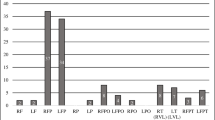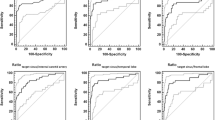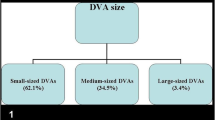Abstract
Purpose
To distinguish cerebral venous clots from patent dural sinuses, cortical veins, and calvarium on high-resolution susceptibility-weighted imaging, since there is lack of a well-designed study in the literature.
Methods
A retrospective review of 51 consecutive cases and 27 controls was performed with susceptibility-weighted imaging independently by two investigators. MR venography along with MR sequences other than the susceptibility-weighted imaging served as the reference standard.
Results
There were 29 males and 49 females in the age range of 1 month to 70 years (mean 27 ± 19.8 years). Substantial (k 0.84 to 1.0) to good (k 0.60 to 0.75) inter-rater agreement was observed on the magnitude images for the demonstration of clots in all venous segments, excluding left sigmoid sinus, jugular bulb, and internal jugular vein (k 0.43 to 0.56). Comparatively magnitude images demonstrated better sensitivity (0.83 (0.54–1.13) to 1.0), specificity (0.92 (0.85–0.99) to 1.0), and negative predictive value (0.98 (0.94–1.02) to 1.0) for the detection of clots across all venous segments. Magnitude images showed positive predictive value ranging from 0.83 (0.66–1.0) to 1.0 for clots anywhere from the anterior aspect of superior sagittal sinus to bilateral transverse sinuses. For the detection of clots from bilateral sigmoid sinuses to internal jugular veins, magnitude images showed relatively better positive predictive value ranging from 0.57 (0.20–0.94) to 0.75 (0.45–1.06) in comparison to the processed magnitude and minimum intensity pixel images.
Conclusion
Susceptibility-weighted imaging can successfully distinguish majority of clots from patent dural sinuses, cortical veins, and calvarium with excellent inter-rater agreements.




Similar content being viewed by others
References
Dmytriw AA, Song JSA, Yu E, Poon CS (2018) Cerebral venous thrombosis: state of the art diagnosis and management. Neuroradiology 60:669–685. https://doi.org/10.1007/s00234-018-2032-2
Yang Q, Duan J, Fan Z, Qu X, Xie Y, Nguyen C, Du X, Bi X, Li K, Ji X, Li D (2016) Early detection and quantification of cerebral venous thrombosis by magnetic resonance black-blood thrombus imaging. Stroke 47:404–409. https://doi.org/10.1161/STROKEAHA.115.011369
Leach JL, Strub WM, Gaskill-Shipley MF (2007) Cerebral venous thrombus signal intensity and susceptibility effects on gradient recalled-echo MR imaging. AJNR Am J Neuroradiol 28:940–945
Altinkaya N, Demir S, Alkan O, Tan M (2015) Diagnostic value of T2*-weighted gradient-echo MRI for segmental evaluation in cerebral venous sinus thrombosis. Clin Imaging 39:15–19. https://doi.org/10.1016/j.clinimag.2014.07.002
Aoki J, Iguchi Y, Kimura K, Yamashita S, Shibazaki K, Terasawa Y (2009) Serial T2*WI studies in the acute phase of cerebral venous thrombosis. Intern Med 48:383–385. https://doi.org/10.2169/internalmedicine.48.1729
Idbaih A, Boukobza M, Crassard I, Porcher R, Bousser MG, Chabriat H (2006) MRI of clot in cerebral venous thrombosis: high diagnostic value of susceptibility-weighted images. Stroke 37:991–995. https://doi.org/10.1161/01.STR.0000206282.85610.ae
Fellner FA, Fellner C, Aichner FT (2005) Mölzer G (2005) Importance of T2*-weighted gradient-echo MRI for diagnosis of cortical vein thrombosis. Eur J Radiol 56:235–239. https://doi.org/10.1016/j.ejrad.2005.05.010
Boukobza M, Crassard I, Bousser MG, Chabriat H (2009) MR imaging features of isolated cortical vein thrombosis: diagnosis and follow-up. AJNR Am J Neuroradiol 30:344–348. https://doi.org/10.3174/ajnr.A1332
Linn J, Michl S, Katja B, Pfefferkorn T, Wiesmann M, Hartz S, Dichgans M, Brückmann H (2010) Cortical vein thrombosis: the diagnostic value of different imaging modalities. Neuroradiology 52:899–911. https://doi.org/10.1007/s00234-010-0654-0
Sadigh G, Mullins ME, Saindane AM (2016) Diagnostic performance of MRI sequences for evaluation of dural venous sinus thrombosis. AJR Am J Roentgenol 206:1298–1306. https://doi.org/10.2214/AJR.15.15719
Patel D, Machnowska M, Symons S, Yeung R, Fox AJ, Aviv RI, JabehdarMaralani P (2016) Diagnostic performance of routine brain MRI sequences for dural venous sinus thrombosis. AJNR Am J Neuroradiol 37:2026–2032. https://doi.org/10.3174/ajnr.A4843
Jalli R, Zarei F, Farahangiz S, Khaleghi F, Petramfar P, Borhani-Haghighi A, Yadollahikhales G (2016) The sensitivity, specificity, and accuracy of contrast-enhanced T1-weighted image, T2*-weighted image, and magnetic resonance venography in diagnosis of cerebral venous sinus thrombosis. J Stroke Cerebrovasc Dis 25:2083–2086. https://doi.org/10.1016/j.jstrokecerebrovasdis.2016.01.039
Bidar F, Faeghi F, Ghorbani A (2016) Assessment of cerebral venous sinus thrombosis using T2 (*)-weighted gradient echo magnetic resonance imaging sequences. Iran J Neurol 15:96–99
Selim M, Fink J, Linfante I, Kumar S, Schlaug G, Caplan LR (2002) Diagnosis of cerebral venous thrombosis with echo-planar T2*-weighted magnetic resonance imaging. Arch Neurol 59:1021–1026. https://doi.org/10.1001/archneur.59.6.1021
Ihn YK, Jung WS, Hwang SS (2013) The value of T2*-weighted gradient-echo MRI for the diagnosis of cerebral venous sinus thrombosis. Clin Imaging 37:446–450. https://doi.org/10.1016/j.clinimag.2012.09.003
Haacke EM, Mittal S, Wu Z, Neelavalli J, Cheng YC (2009) Susceptibility-weighted imaging: technical aspects and clinical applications, part 1. AJNR Am J Neuroradiol 30:19–30. https://doi.org/10.3174/ajnr.A1400
Haller S, Haacke EM, Thurnher MM, Barkhof F (2021) Susceptibility-weighted imaging: technical essentials and clinical neurologic applications. Radiology 299:3–26. https://doi.org/10.1148/radiol.2021203071
Dempfle AK, Harloff A, Schuchardt F, Bäuerle J, Yang S, Urbach H, Egger K (2018) Longitudinal volume quantification of deep medullary veins in patients with cerebral venous sinus thrombosis: venous volume assessment in cerebral venous sinus thrombosis using SWI. Clin Neuroradiol 28:493–499. https://doi.org/10.1007/s00062-017-0602-z
Bracken J, Barnacle A, Ditchfield M (2013) Potential pitfalls in imaging of paediatric cerebral sinovenous thrombosis. Pediatr Radiol 43:219–231. https://doi.org/10.1007/s00247-012-2402-6
Landis JR, Koch GG (1977) The measurement of observer agreement for categorical data. Biometrics 33:159–174
Atlas SW, Mark AS, Grossman RI, Gomori JM (1988) Intracranial hemorrhage: gradient-echo MR imaging at 1.5 T. Comparison with spin-echo imaging and clinical applications. Radiology 168:803–807. https://doi.org/10.1148/radiology.168.3.3406410
Kawabori M, Kuroda S, Kudo K, Terae S, Kaneda M, Nakayama N, Iwasaki Y (2009) Susceptibility-weighted magnetic resonance imaging detects impaired cerebral hemodynamics in the superior sagittal sinus thrombosis–case report. Neurol Med Chir (Tokyo) 49:248–251. https://doi.org/10.2176/nmc.49.248
Mittal S, Wu Z, Neelavalli J, Haacke EM (2009) Susceptibility-weighted imaging: technical aspects and clinical applications, part 2. AJNR Am J Neuroradiol 30:232–252. https://doi.org/10.3174/ajnr.A1461
Pfefferkorn T, Crassard I, Linn J, Dichgans M, Boukobza M, Bousser MG (2009) Clinical features, course and outcome in deep cerebral venous system thrombosis: an analysis of 32 cases. J Neurol 256:1839–1845. https://doi.org/10.1007/s00415-009-5206-3
Aguiar de Sousa D, Lucas Neto L, Jung S, Penas S, Panos L, Heldner MR, Fischer U, Arnold M, Canhão P, El-Koussy M, Ferro JM, Hakim A (2019) Brush sign is associated with increased severity in cerebral venous thrombosis. Stroke 50:1574–1577. https://doi.org/10.1161/STROKEAHA.119.025342
Sato T, Terasawa Y, Mitsumura H, Komatsu T, Sakuta K, Sakai K, Matsushima S, Iguchi Y (2017) Venous stasis and cerebrovascular complications in cerebral venous sinus thrombosis. Eur Neurol 78:154–160. https://doi.org/10.1159/000478980
Author information
Authors and Affiliations
Corresponding author
Ethics declarations
Declarations
The study complies with the ethical standards.
Conflict of interest
The authors declare that they have no conflict of interest.
Ethical approval
All the procedures performed in the studies involving human participants were in accordance with the ethical standards of the institutional and/or national research committee and with the 1964 Helsinki Declaration and its later amendments or comparable ethical standards.
Informed consent
Waiver of consent was obtained from the Institutional Review Board.
Additional information
Publisher's note
Springer Nature remains neutral with regard to jurisdictional claims in published maps and institutional affiliations.
Supplementary Information
Below is the link to the electronic supplementary material.
Rights and permissions
About this article
Cite this article
Boukerche, F., Balakrishnan, S., Kalapos, P. et al. High-resolution susceptibility-weighted imaging of clots in cerebral venous thrombosis. Neuroradiology 64, 2267–2275 (2022). https://doi.org/10.1007/s00234-022-03011-x
Received:
Accepted:
Published:
Issue Date:
DOI: https://doi.org/10.1007/s00234-022-03011-x




